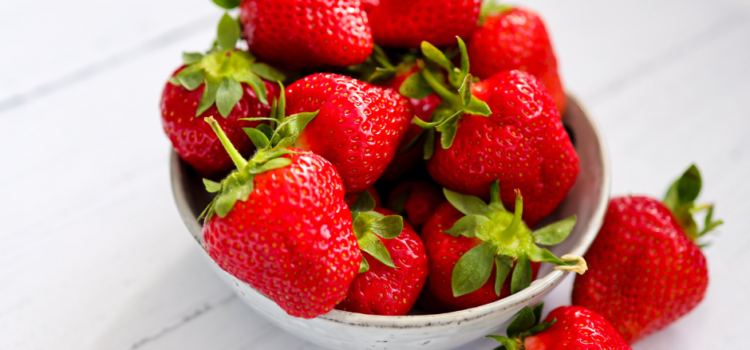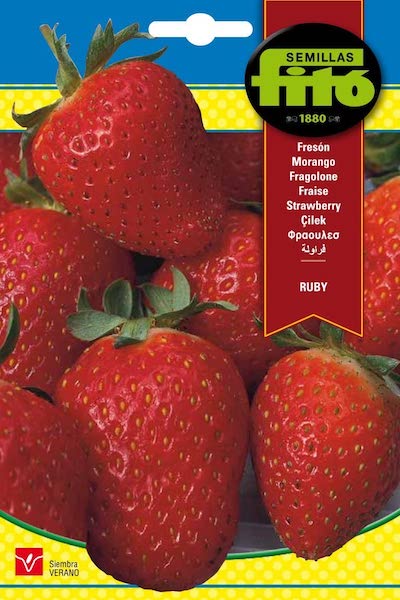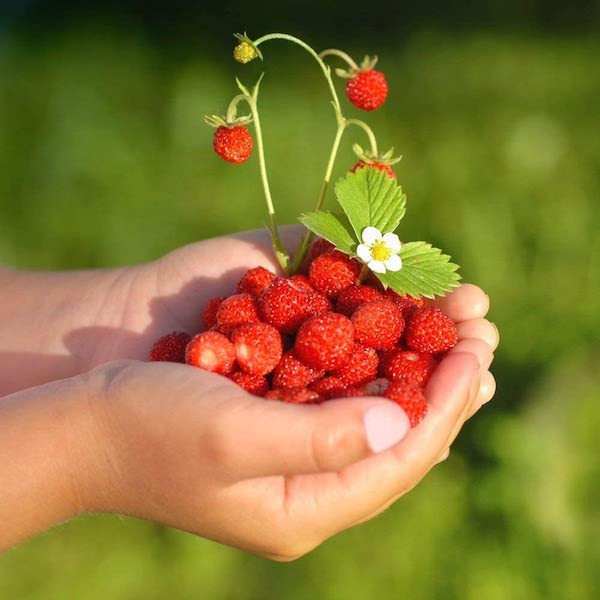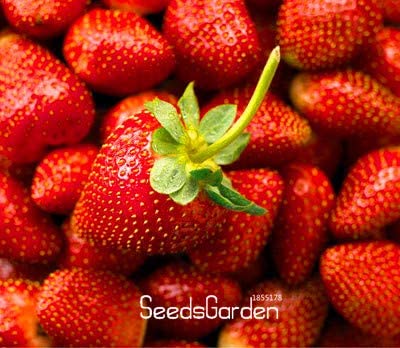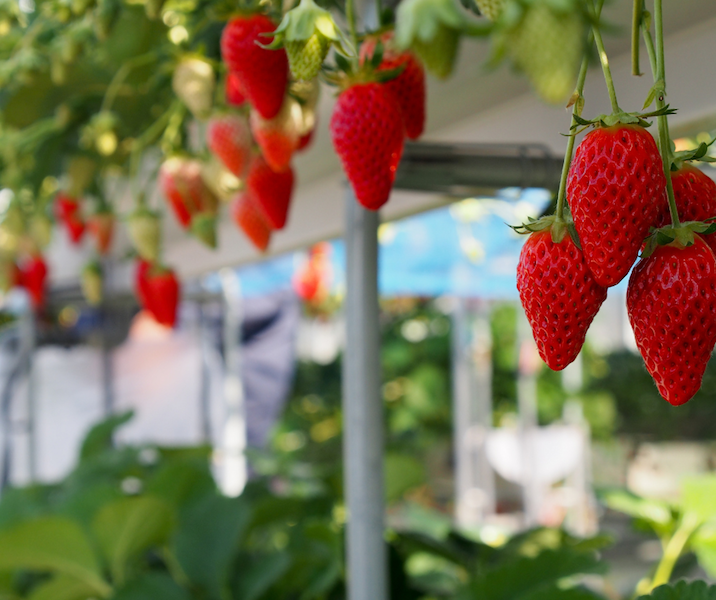Discover the Secret to Growing Fresh and Sweet Strawberries on Spain's Costa Blanca! Tips, Varieties and More!
Growing your own Strawberries on the Costa Blanca
Growing strawberries on the Costa Blanca, whether on your terrace or garden, has several benefits.
Firstly, the Costa Blanca is known for its sunny and warm climate, making it an ideal location for growing strawberries. With plenty of sunshine and moderate temperatures, strawberries can thrive and produce a bountiful harvest.
Secondly, growing strawberries on your terrace or garden can be a rewarding and fun hobby. Strawberries are easy to grow, and even beginners can enjoy a successful crop. You can watch your plants grow and fruit throughout the season, providing a sense of satisfaction and accomplishment.
In addition to the joy of growing your own strawberries, there are also health benefits. Strawberries are a rich source of vitamin C, fiber, and antioxidants. Eating fresh strawberries can help boost your immune system, improve digestion, and support heart health.
Finally, growing strawberries on your terrace or garden can be a cost-effective way to enjoy this delicious fruit. Buying fresh strawberries at the supermarket can be expensive, especially if you want to buy organic or locally grown produce. By growing your own, you can save money and enjoy the freshest, most flavorful strawberries right at home.
Overall, growing strawberries on the Costa Blanca is a great way to enjoy the benefits of gardening, while also enjoying fresh, healthy, and delicious fruit.
Lets take a look into some of the best Strawberries varieties you can grow on the Costa Blanca
Fresón Ruby Strawberry Bright Red In Color and Large Size with a Sweet and Juicy Flavor
The Costa Blanca is a popular region for growing strawberries, including the Fresón Ruby variety. These sweet and juicy strawberries are known for their bright red color and large size, and are a popular choice among growers and consumers alike. If you’re interested in growing Fresón Ruby strawberries on the Costa Blanca, here are some tips to help you get started:
- Choose the Right Location: Fresón Ruby strawberries require plenty of sunlight and well-drained soil to thrive. Choose a location that receives at least 6 hours of sunlight per day and has good drainage to avoid waterlogged soil. Raised beds can be a good option if your soil is heavy or poorly drained.
- Prepare the Soil: Before planting your Fresón Ruby strawberries, prepare the soil by adding organic matter such as compost or well-rotted manure. This will help to improve soil fertility and structure, and provide a good environment for your plants to grow.
- Plant Your Strawberries: Fresón Ruby strawberries are typically planted in the autumn, around October or November. Plant them in rows, spacing the plants around 30cm apart, and water well after planting.
- Provide Regular Watering: Fresón Ruby strawberries require regular watering to keep the soil moist and promote healthy growth. Water your plants deeply once or twice a week, depending on the weather and soil conditions.
- Fertilize Your Plants: To promote healthy growth and fruit production, fertilize your Fresón Ruby strawberries with a balanced fertilizer every 4-6 weeks during the growing season.
- Control Pests and Diseases: Common pests and diseases that can affect Fresón Ruby strawberries include slugs, snails, aphids, and powdery mildew. Use organic pest control methods and fungicides as needed to keep your plants healthy.
By following these tips, you can grow delicious and healthy Fresón Ruby strawberries on the Costa Blanca. Whether you plan to eat them fresh or use them in desserts and other dishes, these flavorful strawberries are sure to be a hit with your family and friends. You can order the seeds below.
Rugia Wild Strawberries Sweet Taste & Aromatic Fragrance
Rugia wild strawberries are a delightful variety of the fruit that is popularly grown for its sweet taste and aromatic fragrance. These strawberries, also known as fragaria vesca or alpine strawberries, are perfect for small gardens and are easy to grow. If you live on the Costa Blanca and want to try your hand at growing Rugia wild strawberries, then this article is for you.
Climate and Soil
Rugia wild strawberries are a hardy plant and can grow well in a variety of climates. However, they prefer cooler temperatures and do not tolerate extreme heat or drought. Therefore, if you are growing them on the Costa Blanca, it is important to choose a spot that is sheltered from the intense heat and sun.
In terms of soil, Rugia wild strawberries prefer a well-drained, slightly acidic soil that is rich in organic matter. If your soil is too alkaline, you can add some peat moss or other organic material to lower the pH level. It is also important to ensure that the soil is well-aerated, as these strawberries have shallow roots and do not like to be waterlogged.
Planting
The best time to plant Rugia wild strawberries is in the early spring, around March or April. You can either purchase seedlings or start from seed. If you are starting from seed, it is best to start them indoors a few weeks before the last frost date, and then transplant them outside once the weather warms up.
When planting, make sure to space the plants about 12 inches apart to allow for adequate air circulation. You can also plant them in containers, which is a great option if you have limited space or if you want to grow them indoors. Just make sure the containers have drainage holes and are filled with a high-quality potting mix.
Care and Maintenance
Rugia wild strawberries require regular watering, especially during dry spells. It is best to water them deeply but infrequently to encourage deep root growth. You can also mulch around the plants to help retain moisture and suppress weeds.
Fertilization is also important to ensure healthy growth and fruit production. You can use a balanced fertilizer once a month during the growing season. Just be careful not to over-fertilize, as this can lead to excessive vegetative growth and fewer fruit.
Pruning is another important aspect of caring for Rugia wild strawberries. It is best to remove any runners that appear, as these can sap energy from the plant and reduce fruit production. You can also remove any yellow or damaged leaves to promote healthy growth.
Harvesting
Rugia wild strawberries are typically ready to harvest in late spring or early summer, depending on the climate. You will know they are ready when they turn bright red and are slightly soft to the touch. It is best to harvest them in the morning when they are cool, as this will help preserve their flavor and texture.
In conclusion, Rugia wild strawberries are a delicious and easy-to-grow fruit that is perfect for the Costa Blanca climate. With the right soil, planting techniques, and care, you can enjoy a bountiful harvest of these fragrant and flavorful strawberries all season long.
Giant Strawberries Large In Size Sweet Juicy Flavor
Four Seasons Giant Strawberries are a unique variety of strawberry that is renowned for its large size and sweet, juicy flavor. These strawberries are perfect for growing on the Costa Blanca, as they are a hardy plant that can tolerate the warm, Mediterranean climate. In this article, we will discuss everything you need to know about growing Four Seasons Giant Strawberries on the Costa Blanca.
Climate and Soil
Four Seasons Giant Strawberries thrive in warm, sunny climates with moderate temperatures. They prefer temperatures between 60 and 80 degrees Fahrenheit and can tolerate some heat and drought. However, they require plenty of water to thrive and should be planted in well-drained soil that is rich in organic matter.
In terms of soil, Four Seasons Giant Strawberries prefer a slightly acidic soil with a pH level between 5.5 and 6.5. You can adjust the pH level of your soil by adding lime if it is too acidic or sulfur if it is too alkaline. It is also important to ensure that the soil is well-drained, as these strawberries do not like to be waterlogged.
Planting
The best time to plant Four Seasons Giant Strawberries on the Costa Blanca is in the fall, between September and November. This allows the plants to establish themselves before the hot summer months. You can either purchase seedlings or start from seed. If you are starting from seed, it is best to start them indoors a few weeks before the last frost date and then transplant them outside once the weather warms up.
When planting, make sure to space the plants about 12 to 18 inches apart to allow for adequate air circulation. You can also plant them in containers, which is a great option if you have limited space or if you want to grow them indoors. Just make sure the containers have drainage holes and are filled with a high-quality potting mix.
Care and Maintenance
Four Seasons Giant Strawberries require regular watering, especially during dry spells. It is best to water them deeply but infrequently to encourage deep root growth. You can also mulch around the plants to help retain moisture and suppress weeds.
Fertilization is also important to ensure healthy growth and fruit production. You can use a balanced fertilizer once a month during the growing season. Just be careful not to over-fertilize, as this can lead to excessive vegetative growth and fewer fruit.
Pruning is another important aspect of caring for Four Seasons Giant Strawberries. It is best to remove any runners that appear, as these can sap energy from the plant and reduce fruit production. You can also remove any yellow or damaged leaves to promote healthy growth.
Harvesting
Four Seasons Giant Strawberries are typically ready to harvest in the late spring or early summer, depending on the climate. You will know they are ready when they turn bright red and are slightly soft to the touch. It is best to harvest them in the morning when they are cool, as this will help preserve their flavor and texture.
In conclusion, Four Seasons Giant Strawberries are a delicious and easy-to-grow fruit that is perfect for the Costa Blanca climate. With the right soil, planting techniques, and care, you can enjoy a bountiful harvest of these flavorful strawberries all season long.
Hanging Strawberries Sweet & Juicy Flavor
Climbing strawberries, also known as hanging or trailing strawberries, have a deliciously sweet and juicy flavor. They are typically smaller than traditional garden strawberries, but they pack a punch in terms of taste. The flavor profile of climbing strawberries is often described as intense, with a perfect balance of sweetness and tartness. They also have a slightly softer texture compared to traditional strawberries, which makes them perfect for eating fresh or using in desserts like jams, pies, and cakes. Overall, the taste of climbing strawberries is truly exceptional and a real treat for strawberry lovers.
Growing Climbing or Trailing Strawberries
Climbing strawberries are a unique and beautiful variety of strawberries that are perfect for growing along the white washed walls of the Costa Blanca. These strawberries, also known as hanging strawberries or trailing strawberries, produce long vines that can climb and cascade down walls, creating a stunning visual display. In this article, we will discuss everything you need to know about growing climbing strawberries along the Costa Blanca.
Climate and Soil
Climbing strawberries are versatile plants that can grow in a range of climates. They prefer moderate temperatures and are best suited for growing in the fall, winter, and spring on the Costa Blanca. They can tolerate heat and drought to some extent, but they require regular watering to thrive.
In terms of soil, these strawberries prefer well-drained, slightly acidic soil with a pH level between 5.5 and 6.5. You can amend your soil with compost or other organic matter to improve its drainage and fertility. It is also important to ensure that the soil is free of rocks, as these can impede root growth.
Planting
The best time to plant climbing strawberries on the Costa Blanca is in the fall or winter, between October and January. You can either purchase seedlings or start from seed. If you are starting from seed, it is best to start them indoors a few weeks before the last frost date and then transplant them outside once the weather warms up.
When planting, make sure to space the plants about 8 to 10 inches apart to allow for adequate air circulation. You can also plant them in containers, which is a great option if you have limited space or if you want to grow them indoors. Just make sure the containers have drainage holes and are filled with a high-quality potting mix.
Care and Maintenance
Climbing strawberries require regular watering, especially during dry spells. It is best to water them deeply but infrequently to encourage deep root growth. You can also mulch around the plants to help retain moisture and suppress weeds.
Fertilization is also important to ensure healthy growth and fruit production. You can use a balanced fertilizer once a month during the growing season. Just be careful not to over-fertilize, as this can lead to excessive vegetative growth and fewer fruit.
Pruning is not usually necessary for climbing strawberries, as they do not produce runners like other strawberry varieties. However, you can remove any yellow or damaged leaves to promote healthy growth.
Training the Vines
Training the vines is an important aspect of growing climbing strawberries. You can use trellises, stakes, or other supports to train the vines to climb along the walls. As the vines grow, gently tie them to the supports using twine or garden tape.
Harvesting
Climbing strawberries are typically ready to harvest in the spring and early summer, depending on the climate. You will know they are ready when they turn bright red and are slightly soft to the touch. It is best to harvest them in the morning when they are cool, as this will help preserve their flavor and texture.
In conclusion, climbing strawberries are a stunning and unique variety of strawberries that are perfect for growing along the white washed walls of the Costa Blanca. With the right soil, planting techniques, and care, you can enjoy a bountiful harvest of these flavorful strawberries all season long while creating a beautiful display.
Growing your own strawberries on the Costa Blanca can be a rewarding and delicious experience. Strawberries are relatively easy to grow, and with the right care and attention, you can enjoy a bountiful harvest of sweet, juicy fruit.
Here are some tips on how to successfully grow strawberries on the Costa Blanca:
- Choose the Right Variety: There are many different varieties of strawberries to choose from, each with its own unique flavor and growing requirements. Some popular varieties for the Costa Blanca include the Camarosa, which is a large, juicy strawberry with a bright red color and a sweet flavor, and the Chandler, which is known for its high yields and excellent flavor. Other varieties that can be grown in this region include the Selva, San Andreas, and Albion.
- Provide Plenty of Sunlight: Strawberries need plenty of sunlight to grow and thrive. They should be planted in a location that receives full sun for most of the day. In very hot and dry climates, strawberries may benefit from some shade during the hottest part of the day.
- Keep the Soil Moist: Strawberries need consistently moist soil to grow, but they don’t like to be waterlogged. The soil should be well-draining and rich in organic matter. It’s important to water the strawberries regularly, especially during the warmer months. However, care should be taken not to over-water the plants, as this can lead to root rot.
- Fertilize Regularly: Strawberries are heavy feeders and require regular fertilization to grow and produce fruit. A balanced fertilizer with equal parts nitrogen, phosphorus, and potassium is ideal. Fertilizer should be applied every two to three months during the growing season.
- Control Weeds: Weeds can compete with strawberries for nutrients and water, so it’s important to keep the area around the plants weed-free. Hand weeding or using a mulch can help to control weeds and keep the soil moist.
- Protect from Pests: Strawberries can be vulnerable to pests such as slugs, snails, and birds. To protect the plants, use a physical barrier such as netting or use an organic pest control method such as diatomaceous earth.
By following these tips, you can successfully grow your own delicious strawberries on the Costa Blanca. Not only will you be able to enjoy the taste of fresh, home-grown fruit, but you’ll also be able to take pride in the fact that you grew them yourself.
In conclusion, growing strawberries on the Costa Blanca can be a fun and rewarding experience for gardeners and horticulturists of all skill levels. With the right care and attention, you can enjoy a bountiful harvest of sweet, juicy fruit that’s sure to impress your friends and family.
Some Great Recipes Using Delicious Strawberries:
Strawberry Shortcake Recipe:
Ingredients:
- 2 cups all-purpose flour
- 1/2 cup granulated sugar
- 2 teaspoons baking powder
- 1/2 teaspoon baking soda
- 1/2 teaspoon salt
- 1/2 cup unsalted butter, cold and cut into small cubes
- 2/3 cup buttermilk
- 1 large egg
- 1 teaspoon vanilla extract
- 2 cups fresh strawberries, hulled and sliced
- Whipped cream
Instructions:
- Preheat your oven to 400°F (200°C) and line a baking sheet with parchment paper.
- In a large bowl, whisk together the flour, sugar, baking powder, baking soda, and salt.
- Cut in the cold butter with a pastry blender or two knives until the mixture resembles coarse crumbs.
- In a small bowl, whisk together the buttermilk, egg, and vanilla extract.
- Add the wet ingredients to the dry ingredients and stir until just combined.
- Gently fold in the sliced strawberries.
- Using a large spoon or ice cream scoop, drop the dough onto the prepared baking sheet, leaving about 2 inches between each mound.
- Bake for 15-18 minutes or until the tops are golden brown.
- Allow the shortcakes to cool on the baking sheet for 5 minutes before transferring them to a wire rack to cool completely.
- To serve, slice each shortcake in half horizontally and top with whipped cream and more fresh strawberries.
Enjoy your delicious and easy-to-make strawberry shortcake!
How To Make a Strawberry and Spinach Salad:
Strawberry and Spinach Salad Recipe:
Ingredients:
- 8 oz. baby spinach leaves
- 1 lb. fresh strawberries, hulled and sliced
- 1/2 red onion, thinly sliced
- 1/2 cup crumbled feta cheese
- 1/4 cup sliced almonds, toasted
Dressing:
- 1/4 cup balsamic vinegar
- 1/4 cup olive oil
- 2 tablespoons honey
- 1 teaspoon Dijon mustard
- Salt and pepper, to taste
Instructions:
- In a large bowl, combine the baby spinach leaves, sliced strawberries, red onion, crumbled feta cheese, and toasted almonds.
- In a small bowl, whisk together the balsamic vinegar, olive oil, honey, Dijon mustard, salt, and pepper until well combined.
- Pour the dressing over the salad and toss until everything is evenly coated.
- Serve immediately and enjoy!
This strawberry and spinach salad is a perfect combination of sweet and savory flavors, with the crunch of the toasted almonds and the tangy feta cheese balancing out the sweetness of the strawberries. It’s a refreshing and healthy salad that’s perfect for any occasion.
Chocolate-Covered Strawberries Recipe:
Ingredients:
- 1 lb. fresh strawberries, washed and dried
- 8 oz. semisweet or dark chocolate chips
- 2 tablespoons unsalted butter
- Optional toppings: chopped nuts, sprinkles, coconut flakes, etc.
Instructions:
- Line a baking sheet with parchment paper and set aside.
- In a heatproof bowl, combine the chocolate chips and butter.
- Melt the chocolate and butter mixture using a double boiler or in the microwave, stirring every 20-30 seconds until the chocolate is completely melted and smooth.
- Dip the strawberries into the melted chocolate, holding them by the stems, and place them onto the prepared baking sheet.
- If desired, sprinkle your choice of toppings over the chocolate-covered strawberries while they are still wet.
- Place the baking sheet in the refrigerator for 10-15 minutes to allow the chocolate to harden.
- Once the chocolate is completely hardened, remove the strawberries from the refrigerator and serve them immediately or store them in an airtight container in the refrigerator for up to 3 days.
These chocolate-covered strawberries are a decadent treat that is perfect for Valentine’s Day, special occasions, or simply as an indulgent snack. The combination of rich, dark chocolate and juicy, fresh strawberries is truly irresistible!
Here are More Strawberry Seeds you can take a look at
The reviews on this page reflect the author’s personal opinions and should not be considered as a guarantee of accuracy. The responsibility for any unsatisfactory purchases lies solely with the individual making the purchase and not with the author or this platform. A commission may be earned on purchases made through links on this page

Everything Home and Garden: Exciting New Products and Services to Enhance Your Home and Garden Experience”

